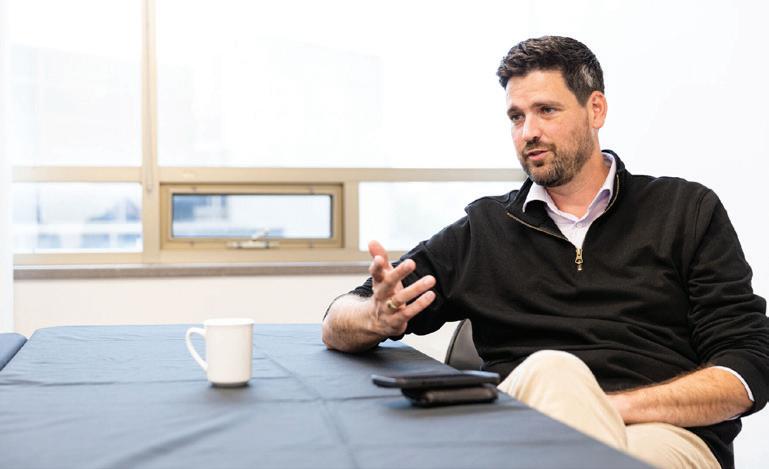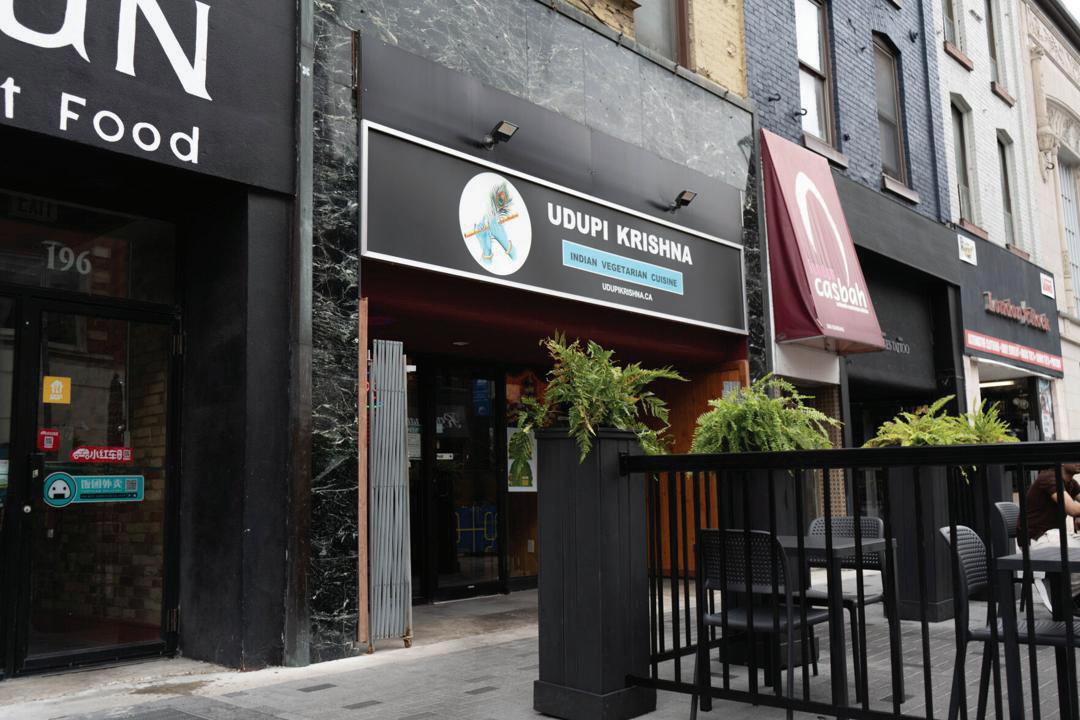






VOLUME 117, ISSUE 2
September 26, 2023
University Community Centre Rm. 263
Western University London, ON, CANADA N6A 3K7 Editorial editor@westerngazette.ca





EDITOR-IN-CHIEF








VOLUME 117, ISSUE 2
September 26, 2023
University Community Centre Rm. 263
Western University London, ON, CANADA N6A 3K7 Editorial editor@westerngazette.ca





EDITOR-IN-CHIEF
Rick McGhie is leaving the Spoke — but not by choice.
The University Students’ Council announced in an Instagram post on Sept. 15 that Rick McGhie, longtime musician performing at Western University, would have his final show at the Spoke on Friday, Sept. 22.

McGhie said to the Gazette on the evening of Sept. 21 after his Grad Club performance, he did not know it would be his last show before he saw the post and that he had no intention to leave the Spoke.
“It was a surprise that they’re going to do this,” said McGhie, adding that he feels “blindsided.”
The musician has been performing at the Spoke for over four decades. “Rick’s Wednesday’s” — McGhie’s weekly performance at the Spoke — has become an iconic tradition beloved by students and alumni.
The USC wrote in a statement to the Gazette that they discuss McGhie’s programming at the Spoke with him every year and communicated the decision with him in advance — ending “Rick’s Wednesday’s.”
“This year, the di cult decision was made to end Rick’s night programming,” wrote the USC. “We had conversations with Rick that seemed mutual at the time, and a decision was made to host a farewell concert at the Spoke.”
McGhie said the USC invited him to a lunch at the Wave about a week and a half before the performance, where he and a manager overseeing the Spoke discussed his future at the venue.
“They wanted to know what I had on my mind for my future,” recalled McGhie. “I just said, you know, ‘I’m not going anywhere.’”
He explained to the manager that he has been undergoing hormone therapy, which caused him to have a sti finger in his left hand, but that he is still able to perform.
“They thought that was a really good way to get rid of me,” alleged McGhie. “They were looking for any way to get rid of me.”
The musician said he’s still not sure why the Spoke removed him and felt frustrated the USC didn’t give him a straight answer.
“I mean if you’re done — you don’t want me, say ‘I don’t want you’ and stop all this, excuse my English, fucking around. You’re making a fool out of yourself and you’re really bringing down the whole decency of the venue.”
The USC’s post saw many comments from students and alumni expressing a ection for McGhie and his legacy at the Spoke — with some wondering why the announcement was so abrupt as well as the reasoning behind McGhie’s departure.
The top comment was a critique on how the event was advertised. An Instagram account with the screen name “Je Armour,” the name of the USC’s chief operating o cer, responded to the top comment.
“We are as sad as you are,” reads the Instagram comment. “But to be clear this is not about profits but instead this is about a human being who has dedicated his life to improve student lives, we should be celebrating his legacy and hoping he enjoys his retirement not talking about profits.”


The Gazette reached out to Armour to confirm this comment but has not heard back by time of publication.
Upon the USC’s announcement of McGhie’s final performance at the Spoke, the Gazette reached out to the student council to request McGhie’s contact information and arrange an interview.
“As for Rick, I’ve talked to my team and it seems like he doesn’t do phone/live interviews anymore,” the USC wrote in an email to the Gazette
McGhie later told the Gazette he is self-employed and was “not aware that I am no longer doing media interviews.”
The musician’s shows bring a large audience to the Spoke — but he did note the atmosphere feels di erent from before the COVID-19 pandemic.
“These people that go to the Spoke now don’t know my legacy,” said McGhie. “Everyone leaves for the last bus, which they never did before.”
The traditions are still strong within the Engineering community, and McGhie expressed how there’s typically a group of 50 engineers who always know the call-backs and teach it to others.
“The engineers are my biggest fans. They teach the next generation,” said McGhie.
McGhie will continue playing at the Grad Club on Thursday nights, as well as performing at alumni events and other special events.
“We are incredibly grateful to Rick for the many years he dedicated to entertaining Western students at the Spoke,” wrote the USC. “His presence on Wednesday nights will truly be missed, and we hope to have the opportunity to work with Rick for special events in the future.”
McGhie’s last performance at the Spoke took place on Sept. 22 from 7 p.m. to 12 a.m. with free admission.
— With files from Estella Ren
OM SHANBHAG STAFF REPORTER
Western will observe the National Day for Truth and Reconciliation on Sept. 29 as a non-instructional day, with the Wampum Learning Lodge holding events throughout the day.

This year will be the first time Western University has cancelled classes to observe this federal statutory holiday — since its approval by Canada’s Parliament in 2021 — to honour those who attended residential schools as well as their families and community.
Western Senate voted in favour of this change in February and amended the university’s Structure of the Academic Year policy.
Western president Alan Shepard described the day as a time to “pause the regular activities of life to contemplate something really important.”
“It won’t work very well if everybody takes it as a day to sleep, it needs to be committed to finding out something about the history of Canada and its relationships to the history of Indigenous peoples, both regionally and nationally.”
The Wampum Learning Lodge, a space designed for Western’s O ce of Indigenous Initiatives to teach and gather, will be holding a sacred fire on Sept. 29, where people can reflect as well as o er prayers and tobacco throughout the day.
“We have the opportunity to reflect on the truth of what has happened to Indigenous peoples here on Turtle Island through colonization,” said Bressette, “but then also acknowledge that truth and the factors that created it as we come together to reconcile.”
Fourth-year software engineering student Abdullah Al Jarad said he plans to spend the non-instructional day with family, praying and catching up on school work.
“It’s a great day to reflect on the history of this country, the things that didn’t go well in the past and stu that we can learn from,” said Al Jarad.
All articles, letters, photographs, graphics, illustrations
The National Day for Truth and Reconciliation, also observed as Orange Shirt Day, o cially falls on Sept. 30, and provides the opportunity to “reflect on the truth and then reflect on reconciliation,” said Christy Bressette, vice-provost and associate vice president for Indigenous initiatives. According to Bressette, 75 per cent of schools across the country observe the National Day for Truth and Reconciliation through a noninstructional day.
Elder Mike Hopkins, from the N’Amerind Friendship Centre in London, will lead the fire featuring stories and teachings about living in balance with the world.
At 10 a.m., the Indigenous initiatives o ce, partnered with Atlohsa Family Healing Services, will host a panel — the first in a series of events — entitled ReconciliACTION: An (Un)Learning Series. This panel will be broadcast virtually for those who cannot attend in person.
According to Bressette, programming for the National Day for Truth and Reconciliation will grow in the years to come, with increasing events and opportunities for active engagement.
“We’re going to educate people a little bit more, we’re going to be able to narrow the gap that exists between two di erent world viewpoints and we’re going to become that much closer to reconciling with each other and the earth,” said Bressette.
Faculty unions and some Brescia students are criticizing the upcoming merger between Brescia and Western in May 2024 — with statements, petitions and viral social media posts.
Western University announced on Sept. 21 that Brescia University College would be integrating with Western starting April 30, 2024. All students enrolled at the all-women’s a liate college will be merged into the main campus but can remain in their program to complete studies for the duration of their degree.
Heather Kirk, the vice-president of the Brescia Faculty Association, said in a statement to the Gazette that the union condemns Brescia’s integration decision.
According to Kirk, Brescia and Western did not have any consultations with the faculty union and they were not informed of the integration until 1:30 p.m. on Sept. 21.
“We were blindsided by the news,” Kirk said.
University of Western Ontario Faculty Association president Rachel Heydon sent an email to faculty members on Sept. 22, saying “we are appalled that this decision was made without consulting either Brescia’s Faculty Association or UWOFA, despite the implications for members of both unions.”
Western clarified in a statement to the Gazette the announcement was “only the first step” in the integration process and the university will be “working closely with employee groups including the faculty unions as we move forward in the coming months.”
Brescia was founded in 1919 by the Ursuline Sisters with the goal of bridging gaps
in women’s education. According to Brescia president Lauretta Frederking, women now make up the majority of post-secondary students in Canada and there is an important need to adapt to new realities.
“In the 1960s, there were 280 women’s universities. There are 26 [now]. We really wanted to think about how we can increase access to underrepresented students to make Western better and to transform our Brescia campus,” Frederking told the Gazette
Brescia students have started a “Help the Students of Canada’s Last Women’s University” petition calling to “save our school and at least allow us to finish our degrees.”
Second-year history student Hermione Ramsay Speers, who started the petition, called the merger a “blow to women in Canada.” The petition has garnered over 3,082 signatures by Sept. 23.
Fourth-year Brescia criminal justice student Emily Green started another petition on the morning of Sept. 22 after seeing and experiencing the “raw emotion” from the Brescia community in response to the merger.
“The overwhelming feeling of people, strong women losing their place to be strong women. It’s heartbreaking,” said Green. Green recalled seeing a faculty meeting shortly after the announcement with everyone hugging and crying.
Brescia sent an email to students on the afternoon of Sept. 21 inviting them to attend a meeting with Brescia’s president and provost. Green said her class was cut short at 4:30 p.m. so students could attend the meeting at 5:30 p.m..
“We understand this announcement will come as a surprise and with that may come a sense of loss,” Frederking said in the email to students.
“While we are excited about the new opportunities
this integration presents, we empathize deeply with the ways our students may feel upon receiving this news and in the coming days.”
Green described the classroom as being completely filled, with many students standing because there was no more space.
Throughout the meeting, “people were actually speaking out, booing, clapping, like very raw emotion,” said Green.
Mya Kestle, a fourth-year nutrition and dietetics student at Brescia, was in class when the news broke and was so shocked, she couldn’t focus on the class content.
“There were definitely a lot of tears on campus leaving the classroom. Everyone was just crying, we didn’t know what the future was gonna hold. No explanation as to why this was happening.”
Kestle said the news was “stressful” for first-year students because they entered Brescia “knowing that they were going to be in the safe all-women’s school for their four-year undergrad and now, they’re going to be a Western student.”
She added the Brescia community has always guided students through their undergrad as a “safe and non-judgemental space.”
There is little worry about gender-based sexual violence at Brescia, which has been an issue discussed at Western — particularly since the allegations of GBSV at Western’s Orientation Week in 2021, according to Kestle.
“It’s just so safe here,” said Kestle. “Your professors know your names, you can talk to anyone, ask them a question and not feel judged.”
Huron University College president Barry Craig said in an email to Huron students, as long as he is president, “Huron will not be merging or otherwise renouncing our autonomy.”
King’s University College president David Malloy also confirmed in an email to students that
King’s will remain an a liate college of Western.
According to Malloy, Western will integrate some of Brescia’s unique programs — including Foods and Nutrition, Family Studies and Human Development — into their faculties and o er these programs to King’s students.
“At King’s, we are ready to provide academic support and a home to any Brescia students looking for all that we can o er,” Malloy wrote in the email.
Brescia students will continue to have priority for placement in their former residence, Clare Hall — which will become part of Western as of May 1, 2024. The integrated residence space comes as Western aims to expand its student population to 50,000 by 2030, according to the university’s strategic plan, Towards Western at 150.
As a student who has a brain injury, Green said the merger erasing small class sizes at Brescia will have a significant accessibility impact on students who have disabilities.
The a liate’s small class size “makes me feel like I can talk and be open to participate and ask questions and I know a lot of people feel that way,” said Green.
When asked whether Brescia’s small class sizes would change in the future, Shepard called it “very complicated” and said it’s “extremely expensive” to o er a lot of small classes while Western does o er some on main campus.
Green believes students will “fight back” against the merger with the petitions and protests in the future.
“I expect protests, I expect there to be meetings about this, I expect students to be very uncomfortable. Because personally going to class today after hearing the news and how it made me feel last night, I was uncomfortable.”
Around 1,000 demonstrators gathered in support of or against LGBTQ2+ education in K–12 schools, in front of the downtown Thames Valley District School Board headquarters on the morning of Sept. 20.

The initial protest was organized as part of “1 Million March 4 Children,” protesting the “sexual orientation and gender identity curriculum, pronouns, gender ideology and mixed bathrooms” in K–12 schools, according to the protesters’ website.
A counter-protest — organized by multiple groups including the Ontario Federation of Labour — began at 8:30 a.m. ahead of the protest’s 9 a.m. start and saw some Western University students and faculty in attendance.
Similar protests were held in cities across Canada on Sept. 20, including Toronto, Ottawa and Montreal, and were also met with counterprotests.
Earth sciences doctoral student Catheryn Ryan said they were impressed by the number of counter-protestors who showed up.
“I’m here because I’m nonbinary, and I’m proud of it,” said Ryan. “I think that children deserve the chance to grow up and get to know who they are, and to feel safe in their schools and supported by their community.”
The Ontario sexual education curriculum introduces students to sexual orientation in grade five and gender identity and expression in grade eight. In 2018, consultations by the Ontario government found a significant majority of parents supported education on these topics in schools.
Researchers suggest students’ knowledge about gender identity and expression helps transgender and nonbinary youth feel more included in
schools.
As protestors and counter-protestors gathered at the Thames Valley District School Board headquarters on Dundas Street, London Police Service o cers patrolled the building perimeter and eventually lined up on the sidewalk to prevent demonstrators from walking on the school board’s property.
Union members at Western also attended the counter-protest, including the University of Western Ontario Faculty Association, which represents
faculty members, and the Public Service Alliance of Canada Local 610, which represents graduate student teaching assistants and postdoctoral associates.
Western kinesiology professor Mac Ross said he attended the counter-protest to “make sure students know that universities in the city support them, professors support them, that we see them, and that we will turn out when we’re asked to.”
New Brunswick and Saskatchewan passed legislation earlier this year requiring students under
16 to get parental approval for pronoun or name changes at school — that groups like the New Brunswick Medical Society say will negatively impact transgender students.
Demonstrator Sharon Wrighton, part of the “1 Million March 4 Children” protest, told the Gazette she thinks discussion of sexual and gender identity are topics for parents to discuss with children, not schools.
Protesters marched along Highbury Avenue at 11:30 a.m. while counter-protestors remained in front of the Thames Valley District School Board building.
Counter-protesters occupied the sidewalk in front of the TVDSB building early in the morning, leading protesters to congregate across Dundas Street on the sidewalk and outside St. Patrick’s Church. While counter-protesters significantly outnumbered protesters for around the first hour of the protests, by 10:30 a.m. the crowd sizes were roughly equivalent.
At around 11:30 a.m., police closed the road on the section of Dundas Street where the protest was occurring, and diverted tra c to side streets.
TVDSB chair Lori-Ann Pizzolato and director of education Mark Fisher said they “stand in unwavering solidarity with the 2SLGBTQIA+ community today and every day” in a statement published on the TVDSB website.
Second-year politics, philosophy and economics student Austin Wang attended the protest and said he feels many Western students don’t think politics are important, but encouraged students to get involved with activism.
“There’s a lot of hate spreading across Canada,” said Wang. “So it’s important to pay attention, get engaged and show up to things and support the trans and LGBTQIA community.”
Senior federal government o cials including Prime Minister Justin Trudeau and Housing Minister Sean Fraser were in London on Sept. 12 and 13 to discuss the housing crisis and potential solutions for students.
Trudeau announced on Sept. 13 that London has secured a $74 million investment in order to build more than 2,000 a ordable housing units over the next three years.



London is the first Canadian city to receive funding from the $4 billion Housing Accelerator Fund, first announced in the 2022 federal budget, that aims to fast-track construction of homes and address the housing crisis.
The Prime Minister explained that the housing shortage across Canada has led to rising costs.
“It’s not fair to young people who feel like cities are turning their backs on when housing is that expensive,” said Trudeau. “Young people feel like cities don’t want them. They feel like they can’t succeed. But if young people can’t succeed in our cities, where can they succeed?”
When asked by the Gazette about how this fund will benefit students, Trudeau stressed this $4 billion investment will help young people find affordable rental housing while they prepare down payments for their first home.
Fraser told the Gazette during the $74 million announcement, he understands the housing crisis is a “real source of fear for people” and the government is going to do everything they can to build a ordable housing that Canadians need.
The Housing Minister met with senior executives from Western University and Fanshawe College student councils the day before to discuss housing a ordability.
During his visit to Western, Fraser told the Gazette a cap on international student enrolment at universities and colleges is a potential option to address the student housing crisis, along with other measures.

Western president Alan Shepard commented on Fraser’s suggestion in an interview with the Gazette on Aug. 31, saying “it’s unfair to blame international students for the housing crisis” and he is opposed to the cap that would limit the number of international students allowed to study in Canada.
“It seems like a very simple-minded answer to a very complex issue that’s been building for years,” said Shepard, who added about 10 per cent of Western’s undergraduate student population are international students, a number lower than other Canadian universities.
Fraser clarified to the Gazette, he doesn’t want anyone to think international students are to blame for the housing crisis.
“There are many di erent ways we could work on the ability of communities to absorb the number of people that are coming into Canada,” said Fraser. “A cap is one way you could address it.” The government is still conversing with institutions to determine the right solutions.
According to the Canadian Bureau for International Education, there were 807,260 international students in Canada in 2022, up 43 per cent from five years before. Canada’s study permit program does not have a limit on the number of international students who can study in Canada each year.
Western aims to raise the ratio of international students in undergraduate programs up to 20 per cent, according to the university’s strategic plan, Towards Western at 150.
“We’re admitting a significant number of students but not more than we have space for,” said Shepard.
Western is planning to build two new residences — one for first-year students and one for graduate students — so the university can maintain its residence guarantee and alleviate the demand for student housing in London. Construction on the two residences which will o er around 1,000 additional living spots on campus is set to begin in the spring of 2024.
 ANDY YANG SENIOR NEWS EDITOR
ANDY YANG SENIOR NEWS EDITOR
More than 150 members from multiple unions on campus gathered on UC Hill on Sept. 20 at noon to demand increased funding for researchers from the provincial government.

The Public Service Alliance of Canada Local 610 — the graduate teaching assistants’ and postdoctoral associates’ union — organized the demonstration. The union is currently negotiating a new collective agreement for TAs with the university, after the previous agreement expired on Aug. 31.
The rally kicked o with a speech by Karuna DSouza, PSAC 610’s president, who said to the crowd that many postdoctoral students are living in poverty due to a lack of financial support for researchers and they should not “be forced to endure such hardships.”
“We are researchers. We deserve more than mere subsistence,” said DSouza. “We demand a living income, one that at least meets the minimum
annual requirements set by our own government for survival.”
In an email to the Gazette, DSouza said salaries for TAs — a major component of graduate student funding — need to increase to accommodate rising costs of living and housing rents.
PSAC also hosted a rally calling for higher TA wages in February — when they negotiated a new collective agreement for postdoctoral students — and another rally in May calling on increased federal funding for scholarships and research grants.
Graduate and postdoctoral students across Canada have been outspoken in recent months about financial hardship as their stipends have not been adjusted for the increased living costs.
Western guaranteed doctoral students a minimum of $17,000 a year plus tuition and raised the funding to $23,360 for international and domestic doctoral students who start in September 2023.
“We organized this rally to draw attention to inadequate funding of universities by the Ontario government,” said John Kausch, communications chair for PSAC 610 in an interview with the Gazette
“We continue to see our universities and those across the province being transformed into profit-driven institute corporations because of underfunding by the Ford government.”
The gathering also saw members from the University of Western Ontario Faculty Association representing faculty, librarians and archivists, Society of Graduate Students and Canadian Union of Public Employees 2361 representing facilities management. Speakers across unions all spoke on
the lack of provincial funding towards universities.
According to Western’s 2023-24 operating and budgeting document, the university estimates it would receive $284.4 million from the province — about 32 per cent of total revenue — and $480.2 million tuition fees, its main source of revenue.
The librarian and archivists union is currently negotiating its collective agreement with the university and will be in a legal strike position on Oct. 4 if they fail to reach an agreement.
UWOFA president Rachel Heydon encouraged unions to “help with strike” as UWOFA-LA continues to bargain with the university. She added Western’s research and infrastructure is built on the 44 librarians and archivists, but the ratio of 900 students for each librarian is outrageous.
Trevor Shearing, Sergeant at Arms of CUPE
2361 representing facilities management and grounds crew said at the rally he was concerned about public sector job shortages due to underfunding.
“Our workloads are intensifying with no end in sight — sta ng gaps and recruitment issues continue. The quality of student experience has deteriorated but student debt grows,” said Shearing.
The rally continued with a march led by Craig Reynolds, regional executive vice president of PSAC Ontario around University College Hill. Participants chanted slogans like “shut it down,” “so so so, solidarity,” and “Who’s got the power? We got the power! What type of power? Union power!”
The Gazette has reached out to Western University for comment and did not receive a response in time for publication.
Asian grocery giant T&T Supermarket is set to open in the summer of 2024 at Oxford Street and Wonderland Road. It will open in retail space vacated by Food Island Supermarket, making it the largest Asian supermarket in London.
T&T is Canada’s largest Asian supermarket chain — owned by Loblaw Companies Ltd. — with 31 stores across British Columbia, Alberta, Ontario and Quebec.
For Tina Lee, T&T Supermarket’s chief execu-
tive o cer, the decision to expand to London dates back to her years at Western University. She graduated from the Ivey Business School in 2003.
“When I was a student at Western, I carpooled with friends for three hours to the closest T&T in Toronto to get the ingredients I needed to make simple meals in residence,” said Lee in a press release. “Despite the long drive, going to T&T is what cured my feeling of being homesick, having moved to London from Vancouver.”
Twenty years after her graduation, Lee believes London residents and students “crave what T&T
has to o er” and is delighted to bring it to her old alma mater.
“I have been looking to bring T&T to London for a really long time — I want to say years,” said Lee in an interview on London Morning. “And this is the perfect location for it. London is a growing city and we’ve got a great Asian population plus a really important student population.”
Second-year management and organizational studies student Brandon Chen is “super excited” by the announcement.
“I’m from Toronto, so I’m very used to T&T. In
fact, there was a little bit of an adjustment coming along without a really accessible [Asian] grocery store,” said Chen. “There’s a lot of specialty stu … like Chinese, Asian produce, Asian cooking ingredients and snacks.”
The new store will be larger than Food Island’s previous footprint and will create 120 jobs. Planned in-store amenities will include a prepared food section with hot meals, sushi, Hong Kong barbecue pork and a Tianjin crepe station.
As for Chen, he can’t wait for T&T to open.
“It’s gonna be huge.”
MABEL ZHAO CONTRIBUTOR
The USC has introduced a faster ratification process for student clubs. Clubs applying for ratification between Sept. 15 and Oct. 15 can expect to be ratified by January.
Previously, the club ratification process took up to a year, with applications opening in October and decisions sent out as late as April. This new fasttracked process means clubs have the chance to
reap the benefits of being ratified shortly after four months.
Ratified clubs can access University Students’ Council resources like free booking of USC spaces and opportunities to recruit new members during Clubs Week.
Bianca Gouveia, the USC’s vice president of student services, said the motivation behind the change is to make the club system “really simple and understandable for all people involved.”

 VERONICA MACLEAN NEWS EDITOR
VERONICA MACLEAN NEWS EDITOR
Ifyou are a student or a recent graduate looking to purchase a new vehicle, you may be stuck waiting a long time.
A combination of inflation, material shortages and shifting consumer preferences has put strain on the automotive industry. With a shortage of new vehicles being produced, the industry has also seen significant increases in the demand and prices of used vehicles in Canada.
Used vehicle prices in Canada peaked — increasing by 34.5 per cent — during the height of the COVID-19 pandemic in 2020-2021. Prices have only decreased slightly since 2022 and still remain higher than historic levels.
Sales of electric and hybrid vehicles reached record highs in Canada in 2022, reflecting a shift in consumers’ vehicle preferences.
Kevin Laurie, the dealer principal at North London Toyota, told the Gazette in an interview demand for new hybrid vehicles has surpassed many manufacturers’ production rates.
“A lot of manufacturers have had to revamp the way that they do things, scaled down their model lines to only produce a certain number of models, not their whole range of models that were hybrid,” said Laurie.
Supply chain issues like the global microchip shortage have continued to impact the automotive industry. Shortages have caused new vehicle prices to increase amid dwindling inventory levels.
“Shortage of parts has been a real detriment to our industry,” said Dave Vollmer, coordinator of the apprenticeship service technician program at Fanshawe College.
Vollmer explained there are sometimes prolonged wait times for simple repair parts and there are occasionally issues of receiving the wrong parts in orders.
Laurie noted the demand for vehicles has surged over the last few years and the waiting time for new vehicles is long due to ongoing shortages and changing consumer preferences.
“People that were waiting for this new-andimproved vehicle that all of a sudden were told that it’s going to be anywhere from six months to two years, they were in a situation that they had to buy a previously-owned vehicle,” said Laurie.
Vollmer said he believes this has forced people to fix their cars because of the price and the e ort required to find a new car.
When people turn to the used car market, some may not be aware of the risks associated with it.
If a pre-owned vehicle was damaged beyond repair, insurance would only pay for the going rate — which could be thousands less than what the customer had paid for it, explained Laurie.
Salam Radhaa, a fifth-year environmental engineering student, purchased a used 2010 Toyota RAV4 in May for $10,500 through an advertisement on Facebook Marketplace. He needed to purchase a vehicle because his previous car was unsafe to drive.
“I was looking for a car for months,” said Radhaa. “But when I kept looking over and over and over, prices were so high.”
Radhaa added even though the car came with a safety certificate, he had to repair the emergency brake after purchasing the car which cost him “a few hundred dollars.”
“It’s a fine car, nothing’s wrong with it,” said Radhaa. “But it was still too expensive for what it is.”
— with files from Adshayah Sathiaseelan
The USC Clubs Governance Board accepts applications for club ratification every fall. Applications must include a statement of the club’s objectives, a list of executives and members, a proposed club constitution and a budget.
Clubs applying for ratification later than Oct. 15 will be processed on the previous timeline, expecting a ratification decision for the following academic year.
Another recent change made to the clubs sys-

tem was the low-sensory sessions o ered during Clubs Week. Students interested in attending one of the six sessions on Sept. 20 had to register in advance, as attendance was capped at 30 people per each half-hour session.
Gouveia explained the sessions would accommodate students who prefer a less-stimulating environment or have physical-accessibility needs.
“I think that’s just recognizing that each student has very di erent needs,” said Gouveia.
Western University’s bachelor of education program is set to undergo major changes — shifting from 24 to 16 months and moving online for two terms — beginning September 2024.
The program will remain structured as four terms and run 16 months consecutively, eliminating the traditional summer break. Terms three and four will be taught entirely online.
Kathy Hibbert, the associate dean of teacher education, explained the revision process took nearly two years which included consultation with board partners, current teacher candidates and faculty. The changes were approved by the University Senate in June.
Hibbert explained the shift is partially due to the “severe teacher shortage showing up, across the country and other parts of the world.”
She stressed that as London is one of the fastestgrowing cities in Canada, the demand for teachers is particularly high.
With the move to an online third and fourth term, Hibbert explained teacher candidates “would have some good modeling of ... what would be e ective in a teaching and learning environment in an online space.”
“We felt very strongly that’s something that this generation of teacher candidates is going to need to do.”
Katherine Kohl, a first-year bachelor of education student, is a proponent of the switch to online.
“It’ll give a lot of students flexibility, which will be nice,” said Kohl.
Alex Paulger, a second-year student in the bachelor of education program, agreed.
“There are a lot of individuals [for whom] this is their second or third career and they have families,” she said. “I think that switching to online will be a benefit for those individuals.”
Less in-person connection in the new model is worrisome for some current teacher candidates.
“You want to network with other teachers and you can’t really do that if you’re online,” explained Catherine Quan, a second-year bachelor of education student.
Quan felt condensing the program made sense given her experience with the curriculum so far, though the elimination of summer break could be di cult for students looking to work and recharge over the summer months.
“I’m happy that I’m getting to experience the program as a 24-month, because it’s definitely been a transition from undergrad,” Kohl said. “I’m excited to get that summer break.”
According to Western, other revisions to the program will see the addition of two new courses related to the Ontario Human Rights “Right to Read” inquiry, a course on ecojustice and climate action and a two-term capstone research project.

Thousands of partygoers returned to Broughdale for Homecoming 2023 celebrations on Sept. 23, and the crowds who had been calm during the day, returned in the evening to find police shutting down major party streets in the Old North neighbourhood.
Police closed Broughdale Avenue to vehicle tra c around 9 a.m. by placing a City of London snow plow near the Richmond Street intersection. A few hundred partiers filled the streets during the morning, throwing footballs, blasting music on house porches and talking to other students around them.
The crowd reached its peak around 1:30 p.m. at around a few thousand people, but some students were still disappointed by the crowd size compared to last year.

“I was expecting a lot more people, but maybe it’s because I’m late,” said Megha Mathew, a second-year medical sciences student. “We stopped by the football game in the morning and then we made our way here so we’re just walking up and down.”
Returning to HOCO 2023, bedsheet banners also made a comeback on Broughdale Avenue, including ones reading “Queen spits, Western swallows,” “Save a horse, ride a Mustang” and “Queen’s can’t raise MILFS like Western can.”
A group of partygoers gathered at a “speed dating” event hosted by the minds behind Winder — the dating app for Western students — near the intersection of Broughdale Avenue and Richmond Street.
Students sat on opposite sides of a table, so they could interview a potential date and tap a button to
switch out their date for a new person.
“It’s a super popular trend on YouTube,” said Zachary Yungblut, a fourth-year management and organizational studies student and Winder’s chief executive o cer. “We’re going to be doing it to get people at Western specifically interested in Winder.”
Yungblut said the app will launch in 18 days — just in time for Thanksgiving weekend which he said is ironic due to its timing with people being “turkey dumped.”
Similar to last year, metal fence barricades were placed in the middle of Broughdale Avenue, leaving students walking on sidewalks and edges of the road. On Richmond Street, vehicle tra c was reduced to one lane on both sides, also by barricades.
Crowds of police o cers patrolled the streets, with London police assisted by o cers from York Region, Hamilton and Windsor. Members of the York Region Emergency Response Unit — the region’s SWAT team — were also present. On-street cameras and drones were used for video surveillance of Broughdale Avenue, Huron Street and Audrey Avenue.
Partygoers expressed mixed feelings about police presence on the street — many said they believed it was necessary to have law enforcement at the scene, but some added the number of police o cers seemed excessive.
Second-year electrical engineering student Rafi Mettias said he thinks the police o cers are “really scared for not many reasons” but their presence is important in emergency situations.
“Some girl got shot first day of school or something, right? With a BB gun, so it’s good to have them as well,” said Mettias, referencing the incident that took place on Broughdale Avenue during Orientation Week.
Police did not release the number of arrests, tickets and warnings issued in time for publication
but confirmed there were no major disturbances or injuries as of late afternoon on Sept. 23.
Near the university’s main gates, second-year management and organizational studies student Michael Visouvath as well as his business partner held a hanging contest using a pull-up bar — where participants paid $10 to compete and could win $100 if they hung on for two minutes.

“Last year, we actually did the same thing,” said Visouvath. “It went pretty well so we decided to do the same thing this year.”
Visouvath estimated they raised about $500 last year, and expects to raise even more this year since they started the challenge earlier in the day. He said they will donate the profits to the World Food Programme.
Fifth-year medical sciences student Djarren Tan was the first person to win the challenge around 4 p.m. this year. According to Visouvath, there were three winners last year.
“I did it at the [Canadian National Exhibition] and won three times,” said Tan.
On the other side of the street, King Richie’s Pizzeria, the pizza shop located on the corner of Richmond Street and Broughdale Avenue, saw people in purple shirts lining up throughout the day.
“It’s going to be pretty busy after the football game,” Farhad Elind, the owner of King Richie’s, told the Gazette earlier in the morning. “It’s going to be nonstop until, I guess, four or five in the [next] morning — it’s the same thing every year.”
Current students were not the only ones enjoying the liveliness of the street parties — many Western alumni came back to their alma mater during HOCO and set foot on Broughdale Avenue.
Michael Haines and Glenn Wilson, two Western alumni from the class of 1986, decided to check out the scene on Broughdale Avenue because their friend’s child had a house around the corner.
“We find that a lot of the young guys come up to
us and ask us, you know, ‘Was it like this when you were here?’ and absolutely it was,” said Haines.
“I mean, it’s the Western experience, the same as it was when we were here.”
At around 6 p.m. on Sept. 23, police began to clear students o Broughdale Avenue, Audrey Avenue and Huron Street — the major party streets — and by around 7:15 p.m., all three streets were clear. Hundreds of partiers were forced onto the barricaded sidewalks of Richmond Street unsure where to go.
“I feel like everyone’s kind of doing the same thing. Just walking around and trying to find stu to do,” said Madison MacLellan, a first-year medical sciences student.
Several partiers were seen socializing, arguing and taking photos with police o cers. Some who wanted to go back to Broughdale Avenue tried to plead with o cers, but police would not let them enter without proof of address — due to a nuisance party bylaw in place on major party streets.
Police also closed Richmond Street between Bernard Avenue and Huron Street to vehicle tra c for public safety from 6 to 8:45 p.m.
Police encouraged students to stay o the roads, and forced them to keep walking so large groups did not form on the sidewalks.
During HOCO 2022, Broughdale Avenue was cleared o at 6 p.m. but reopened 9:30 p.m and partygoers swarmed the street late into the night, forming mosh pits on Huron Street and forcing police to shut down both streets to vehicle tra c.
Throughout Homecoming evening this year, police and SWAT team members shut down multiple parties in the Old North neighbourhood, including a large party on Epworth Avenue. Large waves of students sporting purple outfits left Epworth Avenue as a police line formed.

Ava Smallwood, a first-year Queen’s University student described watching police walk down the

street with helmets, gas masks and flashlights to clear “hundreds” of partiers from Epworth Avenue.
While some students said they were not surprised to see heavy police presence, others said they didn’t expect the street closures.
First-year health sciences student Mili Shah said she predicted “everyone to be on one street and then parts get shut down in the middle of the night but it’s 9 p.m., and everything’s done now.”
Once the major party streets closed, students started moving north along Richmond Street past University Main Gates to find parties near Epworth Avenue.
At around 9:15 p.m., a member of the London Fire Department was extinguishing what appeared to be burning cloth that was allegedly thrown onto University Drive.
London-Middlesex Emergency Medical Services were seen assessing injured students on Richmond Street, and several ambulances parked close to University Main Gates.
Crowd size remained steady — as around 1,000 students walked up and down Richmond Street — but declined after 11 p.m.. Most students stuck to their social circles and tried to find a party to attend.
Many out-of-town students like third-year York University student Omar Beltagi had travelled from outside London to celebrate HOCO at Western.
“I keep hearing these myths about how Western students are so fun to be around,” said Beltagi while eating a pizza from King Richie’s Pizzeria.
“I think I’m gonna be depressed going back to York,” said Beltagi. “I wish I transferred to Western as soon as I finished my first year.”
 SONIA PERSAUD FEATURES EDITOR
SONIA PERSAUD FEATURES EDITOR
On-campusHOCO events such as Western’s second annual student fan festival and a free pancake breakfast drew thousands of students away from unsanctioned street parties during Homecoming day on Sept. 23.
The university held the student fan festival, an event featuring food trucks, activities and giveaways, outside of Western Alumni Stadium from 11 a.m. to 4 p.m.. Around 2,000 students were at the festival by 12:30 p.m., with more in line to get in.
Betty Hu, a master’s student in physiology and pharmacology, said she and a friend were planning on trying the free food, watching the football game — and avoiding the Broughdale Avenue area, a hub for unsanctioned Homecoming street parties.
Students could scan their Western ONECard for entry and had access to free food from 21 local food trucks — including familiar names like Tikka Tomato, Rocky Mountain Pizza and Mr. and Mrs. Bao. Free merchandise like purple heart-shaped sunglasses was also available.
Hu attended the fan festival last year as an undergraduate and said the previous year had more activities and many of the same food trucks — but she felt the “vibes are really good” at this year’s festival.
Students who came for the fan festival were able to attend Western University’s football game against the University of Ottawa Gee-Gees starting at 1 p.m. at Western Alumni Stadium as well — although many remained outside the venue even after the game had started.
Not all students planned to stay away from Broughdale Avenue — second-year Ivey Business School students Matthew Di Rito and Nicholas Chong said they might check out what was happening on the street after the festival and game.

“I never have plans, I just see where the night takes me,” said Di Rito. “I might end up on Brough-
dale Avenue, I might end up downtown — but either way, I’m here for a good time.”
The fan festival planned hot air balloon rides for students but cancelled them at the last minute.
According to balloon pilot Keith Ferguson, the hot air balloon was set up before the festival opened to students, but the wind picked up and made it too unsafe to o er rides when the gates opened to students at 11 a.m..
Last year, the inaugural fan festival saw between 2,000 and 3,000 students attend before the football game began — even though unsanctioned street parties near campus, such as the ones on Broughdale Avenue, drew larger crowds of around 6,000.
Before the fan festival, students and alumni gathered on Concrete Beach from 9 to 11 a.m. for a free pancake breakfast co-organized by the University Students’ Council and Western’s department of alumni relations and development.
The breakfast featured free pancakes, co ee and a photo station for attendees.
USC president Sunday Ajak was at the pancake breakfast along with other student union executives. Ajak described it as a “really good time” and was pleased with the turnout.
“So far I’ve talked to a lot of really, really fun students. The turnout has been amazing, with a lot of great alumni,” said Ajak.
Mercy Ajayi, a doctoral student in chemistry, said she enjoyed the breakfast as well.
Ajayi is an international student and said she doesn’t often eat Canadian breakfast foods like pancakes — she loved trying them HOCO morning. She planned to attend the football game later in the day and try some more Canadian food.
“Homecoming is an event I would love to attend every year,” said Ajayi. “Last year I attended it too — so when I saw the information I was like ‘woah, I have to attend this year.’”
— with files from Tiana O’Connor
In a heartfelt farewell, Rick McGhie took center stage at the Spoke one last time, closing the chapter on over four decades of music and memories.
The turnout at the Spoke on Sept. 22 was remarkable, with a line that stretched through the University Community Centre main lobby and past Mustang Lounge.
The University Students’ Council announced on Instagram a week earlier that the show on Sept. 22 would be McGhie’s last performance at the Spoke.
While the event was originally advertised to be from 7 to 10 p.m., McGhie performed until just before midnight.
There was a burst of applause as McGhie took the stage, with the crowd chanting “Rick! Rick! Rick!” at multiple points during the night.
“I don’t think I’ve seen so many people in this room before,” McGhie remarked on stage.
Throughout the night, McGhie treated the audience to some of his most beloved songs, including renditions of classics like “Sweet Caroline,” “Take Me Home, Country Roads” and “American Pie.”

As usual, the audience replaced the lyrics of Billy
Joel’s “Piano Man,” bellowing out “Sing us a song of Rick McGhie” instead of the original lyric “Sing us a song, you’re the piano man.”

While the audience celebrated McGhie’s legacy, many audience members also expressed frustrations over the USC’s decision to end McGhie’s run at the Spoke. At one point in the show, the crowd chanted “one more year!”
Western University alumna Kiera Abernethy said they haven’t missed a performance since 2017, except during the pandemic.
“It just shows how important it is to properly advertise and continue Western traditions that make Western what it is,” said Abernethy. ”What the USC did was unfortunately a very terrible decision on their part, and I hope that they will consider rescinding it.”
The audience’s a ection for McGhie was clear by the sea of fans wearing Rick McGhie merchandise. Audience members showcased shirts printed with slogans like “Wednesdays are for Rick” and “OmGhie!”
Faculty of Engineering students — a faculty known for being dedicated McGhie fans — wore faculty-related clothing.
Eesha Sharma, a third-year chemical engineering and artificial intelligence student, wore their engineering jacket to the event.
“Over the years, it has become a tradition for a bunch of Engineering students to use Rick’s as a night to get together,” said Sharma. “We know a lot of the callbacks — it’s a tradition for us to pass down in our Engineering community.”
McGhie’s connection with his audience extended beyond the music. He took time between sets to engage with fans, signing merchandise and taking pictures.
As McGhie concluded his second last song, “You’ve Lost That Lovin’ Feeling” he looked at the audience and said, “Well, you’ve got that lovin’ feeling tonight, let me tell you that.”
McGhie will continue to perform on Thursday nights at the Grad Club.
As a kid, I always dreaded the end of summer. But I knew it meant I was one step closer to the Western Fair, which meant two of my favourite things — walking through the Midway and eating the most delicious funnel cake I had been thinking about all year.
For my family and me, going to the Western Fair was an annual tradition that marked the beginning of fall.

The fair usually takes place the second week of September with this year’s event running from Sept. 8 to 17.
As I walked through the fair’s gates, I was hit with a rush of nostalgia.
Entering the fair made all five of my senses come alive: from the dazzling lights that illuminated the Ferris wheel to the exhilarated screams from people soaring through the sky on swings — the place was alive with booming music and conversation.
To get into the fair, a general admission ticket costs $12 in advance or $15 at the gate. Midway coupons can be purchased once you enter the gates or you can buy a ‘Ride All Day’ wristband. I thought $47 for the wristband was a bit expensive,

especially since there was no student discount, so I opted for the admission pass and took a walk down memory lane.
The fair — now in its 146th year — returned in person with a new layout in 2022 after a two-year hiatus due to the COVID-19 pandemic. Its location was moved from the north side to the south side of Florence Street.
The size of the fairground is smaller than in previous years but it o ers almost everything it always has.
“The o erings are basically the same as they’ve always been,” said Greg Blanchard, director of equine programming at the Western Fair District.
“It is a bit of a misconception that it’s smaller.”
Despite the footprint change, the fair still had all the classic rides I remember like the Himalaya — a high-speed circular roller coaster, the drop tower and the tilt-a-whirl.
But what I miss is the Demolition Derby my family and I used to watch when I was a kid. It hasn’t been o ered in the past couple of years due to the Grandstand being under construction. Blanchard says there are a number of reasons for the change in location, including the repurposing of old buildings and the construction of rapid transit along Dundas Street.
“The fair has certainly changed over the years. Like everything else in life, change is inevitable,” says Blanchard.
Even with the changes in the past couple of years, the fair still seems to be a big success. I was there on the final day. It was raining, but the action didn’t look like it would slow down anytime soon.
“My favourite part is seeing young kids coming out, and just having the time of their lives and the memories that are going to be formed for them,”
says Blanchard. “They’ll grow into adults, and they’ll look back and remember their early days at the fair.”
The memories Blanchard is talking about are the ones that came flooding back to me as I rode the Ferris wheel.
I went higher and higher until I finally had the best view of the fair, completely lit up at night. No matter how much the Western Fair changes, I will always want to go back.
If you’re ever hungry and don’t feel like walking up University College Hill, try walking down to Middlesex College’s basement.
The Grad Club, established by the Society of Graduate Students, has been serving students from the Middlesex College basement since 1979. It’s a common place for graduate students to spend time but all members of the Western University community are welcome to hang out, enjoy a drink or a bite to eat.
“It’s a place for grad students to come and relax, get out of their studies, out of their labs, come and meet other grad students, discuss their studies, what they’re researching and so on,” says Marc Lalonde, the manager of the Grad Club for 18 years.
Jessica Novial, a PhD student in the French studies department and a bartender at the Grad Club describes the atmosphere of the Grad Club as
“cozy,” “relaxed” and “comfortable.”
The Grad Club o ers a full breakfast, lunch and dinner menu including many vegan and vegetarian options. The pub also boasts a full bar with 20 taps, a full cocktail menu and non-alcoholic drinks.
Undergraduate students can use their OneCard to purchase food items since the pub was recently added to the campus meal plan.
“During the day, especially at lunch, we get a lot of undergrads coming in grabbing a bite to eat,” says Lalonde. “Everyone’s welcome.”
There are also decades-old traditions for grad students like The Goblet of Knowledge, which awards a free drink to any students who successfully defend their master’s or PhD thesis.
The Grad Club can get pretty busy as there are a number of weekly and monthly events, including weekly trivia, Rick McGhie performances, karaoke and drag shows. There is a collection of 60 board games available that guests can play anytime. Monthly, the Grad Club hosts the Society of Grad-
uate Students Board Game Night.
Novial says the events add to the pub environment and she enjoys working here. The Grad Club is open Monday from 8 a.m to 7 p.m., Tuesday and Friday 8 a.m. to 11 p.m. and Wednesday and Thursday 8 a.m. to 10 p.m. — which fits the student employees’ schedules.
“The vibe is really chill, it’s not fancy or anything. But that’s what people like about it,” says Novial.
While the pub was established by SOGS, the pub is independently sta ed and Novial mentions former Grad Club employees often come back to the pub to enjoy a drink — something she thinks is a testament to the positive environment.
Although the Grad Club sparked controversy among employees earlier this summer over a lack of communications of the pub’s renovations, Novial expresses the team is overcoming the issues.

The pub reopened after being closed for a remodel from July 31 to Aug. 18, including new paint and patio furniture.
“We are trying to get past the di erences, they did their part, and we are thankful and grateful,” says Novial.
WhileLondon may not be your first thought when it comes to fine dining experiences, it’s a city filled with culinary surprises waiting to be discovered. This guide is here to help. Our recommendations are located either on or steps away from Richmond Street, an easy 15-minute bus ride from Western University’s campus.




179 ALBERT ST.
Tucked away from the bustling crowds of Richmond Street, Mythic Grill provides a warm and intimate atmosphere. The patio also o ers a distinctive setting, decorated with greenery and string lights, making it the perfect spot for date night. Mythic Grill’s menu consists of traditional Greek classics, ranging from spanakopita to souvlaki. A must-try dish is the calamari, and for the full experience, end your meal with some baklava.
Thaifoon is a London gem, o ering a modern twist on Thai classics. The dimly-lit restaurant comes with a cozy ambience, making it an ideal spot for a sit-down meal, but they also o er a take-out menu for those on the go. Most of the entrees come with the choice of tofu or other proteins, providing a wide variety of options for vegetarians. The peanut pasta is a favourite, but the green curry is packed with flavour if you enjoy something spicy. Wash your meal down with a thai iced tea or a drink from Thaifoon’s unique cocktail menu. If you’re going with a larger group, make a reservation beforehand, as they get pretty busy in the evenings.

Spageddy Eddy’s may seem strange as you venture down an alley into a basement, but it only adds to the charm. The restaurant’s walls are decorated with old licence plates and other miscellaneous items. It almost feels like you’re inside your grandpa’s garage, but in the best way possible. Featuring an extensive array of pasta dishes and generous portions, you’re guaranteed to leave the restaurant feeling satisfied and with at least a day’s worth of leftovers. The alfredo sauce is a fan favourite, but don’t overlook the lasagna either.
Acompletely vegetarian restaurant, Udupi Krishna is the spot for authentic South Indian food. Menu highlights include the pav bhaji dosa, a dish consisting of vegetables and potatoes cooked in pav bhaji masala slathered inside a dose — a crepe made of rice, lentil, and wheat — as well as aloo gobi, a cauliflower and potato curry. Compliment your meal with a sweet mango lassi. Udupi Krishna is also an excellent spot for those with dietary restrictions, o ering many vegan, gluten-free and nut-free choices.
The Early Bird knows how to do breakfast right, and the restaurant’s interior is just as impressive. The walls are plastered with music posters, the tables with stickers and the booths with vinyl records. As you take in the colourful interior, you’ll soon discover that the dining experience matches the atmosphere. You can’t go wrong with the classic bird breakfast of eggs, home fries, toast and your choice of bacon, sausage or tofu. But if you’re feeling adventurous, I’d recommend the huevos rancheros. The Early Bird is the perfect spot to enjoy breakfast while having a morning debrief after a night out.
130 KING ST.
NoLondon food list is complete without mentioning Covent Garden Market. While it hosts multiple market vendors, they are also home to several restaurants o ering an endless selection of international foods. Visit Love Pastel to try some Brazilian snacks, or try La Parrillada for authentic Latin cuisine. The New Dehli Deli serves Caribbean cuisine with the best jerk chicken in London. Stop by the Ice Cream Bowl for homemade ice cream and gelato on your way out.

Content warning: The following article contains descriptions of a sexual harrassment experience.
When a woman gets sexually harassed, being on guard is not and can never be the solution.

There is a serious problem with some companies’ lack of transparency and accountability in sexual harassment reporting process. It feels intentionally di cult for people to report so they are discouraged and don’t bother. We need to expect more and demand better — I know this because I faced the system first-hand.
I was an undergraduate student research intern at Western University this summer and divided my time between London and my home in Toronto. One day while waiting to board the bus back to London, the bus driver — a man decades older than me — asked if I wanted to sit in the first few seats on the bus.
Sounded great to me.
you have no escape. Plus, he was the driver, the person you would go to if someone was harassing you on the bus. It’s not easy to get up and talk to someone six rows back.
The first thing I did when I got o the bus at Elgin Hall was look to submit a formal report. To my surprise and disappointment, reporting was almost as frustrating as what happened on the bus.
Not only is there not a specific page on the website to file a driver complaint, but the same customer service number you make a bus reservation or cancellation with is the same one to go to make a sexual harassment complaint.
When I spoke to a customer service representative, it felt like she was simply taking my information and doing whatever she could to resolve the problem without getting higher-ups involved, which seemed to be the goal.
who worked for the company in executive positions, reached out to them there and waited.
An operations manager later called me to apologize for what happened. She explained that if this happened to her two young daughters, she would be scared and furious. To this day, I’m still grateful for her — but this should be the norm for all companies.
A few days after that, I learned the driver was taken o the Toronto-London line and shortly after that, terminated from his position with the company.
My outcome was the one I never thought would happen and is a rarity for many of my female peers: the best-case scenario.
I couldn’t help but wonder if other women had been put in the same position with the same driver.
Just like it is not your fault if you get sexually harassed, it is not your responsibility to report and change the entire flawed system.
My story isn’t an isolated one.
One in three women experiences unwanted sexual behaviour in public which can include unwanted sexual attention or unwanted physical contact. It’s scary to imagine the untold numbers of women whose sense of security was crushed because their stories ended di erently from mine.
Accessible and transparent reporting processes are imperative in people feeling like they have a voice to enact change. Companies need to do better than what I — and inevitably so many other women — experienced in the reporting process. This entails having a specific area on their website for people to report driver-related complaints, listing the names of team members and executives on their website so people can talk to more than a customer service representative and recording complaints exactly and accurately as they’re told.
There were few people on the bus and you usually have to pay extra for the first few seats because there’s a cup holder and extra legroom — ah, an opportunity to relax and listen to Taylor Swift in peace.
About twenty minutes into the ride, the driver told me he o ered me a seat at the front because I “knew what [I] was doing, wearing that sexy revealing tank top.” I was wearing the same shirt I would when I would go to class. He interrogated me about my sex life, asking if I’d ever been asked to wear a strap-on and do BDSM, adding that a girl wanted to do BDSM with him and he “beat the shit out of her twice.” He was also convinced that my height must be a “kink for a lot of guys.”
No matter my answers or lack thereof, he was relentless. He kept pushing.
By text, my mom kept telling me to move to a seat further back where there were people but to be honest, I was frozen. I didn’t go to the back of the bus until the first stop in London — after almost two hours.
The worst part about being harassed on a bus is
The lack of empathy and urgency was made even more apparent to me when I received an email with my report ticket and a loose transcription of what I described. However, a lot of important details were completely left out.
I immediately emailed back and expressed my disappointment. I outlined the things that were excluded and necessary in considering actions and consequences for the driver and that the reporting process was severely lacking.
Meanwhile, back home in Toronto, my parents were as frustrated as I was — maybe more. They also called customer services and asked to speak directly with the company’s managers. No one could — or would — give them anything. When they explained the reason they needed to speak to someone, the customer service representative suggested they call the police to report it.
It was made apparent to me that the reporting process was made di cult on purpose and while I knew the company didn’t want to hear what I had to say, I wasn’t about to give up now.
Next stop, LinkedIn. We found some people
I’m writing this article to tell you you have a voice and it is powerful.
If you feel uncomfortable, report it — one comment is enough. Helping establish a pattern means that even if they don’t get fired, you are helping the next woman make her case.
I want to acknowledge once again that I know I’m lucky. I’ve been an advocate since I was nine and established a platform where I feel powerful enough to speak up and speak out. I know this isn’t the case for everyone, but you shouldn’t have to be an advocate to get a response from the company.
It’s worth noting those things I needed easy access to when reporting have not been added to their website — it has been almost four months.
There’s this hope that victims will be strong enough to report, but then companies make it difficult to report. There are so many layers you have to peel back and you have to be okay repeating yourself over and over, being vulnerable over and over. Companies need to be as vulnerable as they expect us to be. They need to be open to hearing the problems and doing something.
Women deserve to feel safe and empowered everywhere, whether that be in class, at work or on the bus to Western. While gender-based violence is often framed as a women’s issue since the majority of victims are female, it’s not just up to women to support each other in situations like this.
GBSV is not just a women’s issue, it’s a societal one.
HANNAH ALPER OPINIONS EDITOR
Women deserve to feel safe and empowered everywhere, whether that be in class, at work or on the bus to Western.
My outcome was the one I never thought would happen and is a rarity for many of my female peers: the best-case scenario.
While gender-based violence is often framed as a women’s issue since the majority of victims are female, it’s not just up to women to support each other in situations like this.SOPHIE BOUQUILLON GAZETTE Hannah Alper, Sept. 22, 2023.
In wanting to create a healthy routine for myself, I’ve decided I want to try group fitness classes and get active through fun and cool activities. I go to sign up, but now I need to buy a membership. Is my tuition not enough?
The Western University Student Recreation Centre requires students or anyone who wants to participate in group fitness classes like Pilates and Sculpt and Sweat, to pay a $20 per month membership fee.
As someone who is typically pretty conservative with their spending, I don’t feel it’s worth paying to join a group fitness class. If that were the case, I might as well find these classes o campus. The best part about group fitness classes was the ability to go and join in, without having to worry about fees.
It’s hard enough for students without trust funds or large amounts of savings to get by in today’s economy, especially if they are trying to be healthy and fit. Grocery prices have skyrocketed and it is becoming harder and harder to stay on a balanced budget, while also trying to eat healthy and buy the necessities.
Although $20 once a month might not seem like much in the grand scheme of things, if you actively attend these classes during both the fall and winter semesters, the membership total sums up to $160 — or $100 for an 8-month membership. With the extremities of the housing crisis in Ontario as well as the inflation of groceries and other necessities — yes, $160 is a lot.
We already pay for various ancillary fees in addition to the cost of tuition, so why wouldn’t
group fitness classes be included in that list? In the past, group fitness classes — along with access to the Rec Centre — have been free of charge for students, making the gym environment easy to attend.
For first-timers at the gym, it can be intimidating to get started on your fitness journey, and as someone who attends the Rec Centre, I still get scared walking into all the gym rats and fitness girls around me. Group fitness classes are there to promote connection in the fitness world — everyone is working out in the same class, all together, so it becomes less intimidating.
If you’re someone who is already discouraged from working out in the Rec Centre, or especially intimidated to join group classes, there becomes this internal conflict, whether you should or shouldn’t pay the $20 per month fee.
Juggling school, health and fitness is hard enough, not to mention an overcrowded gym is intimidating and hard to work around. Now fitness classes cost money in an economy where students are struggling to a ord what they need.
— Aria Title, third-year media, information and technoculture student and Radio Western host








To submit a community opinions article, email opinions@westerngazette.ca





behind in school, missing hangouts with friends or even developing long COVID-19.
SONIA PERSAUD FEATURES EDITOR

Itwouldn’t be the beginning of a new school year without half the university coming down with the frosh flu. Whether it’s influenza or COVID-19, if you end up claimed by coughing fits, please put on a mask.
If you’re sick, stay home, but if you need to come to campus, putting on a mask is the least you can do. It can do a lot to help community members — with little cost to you.
Even though Western University has removed its mask mandate, we as students still have a moral responsibility to wear a mask when we’re sick and in public to reduce the risk of infecting others. Masks help to protect our community members from infectious diseases like COVID-19, which has seen a recent surge across demographics.
Even though some of us are at a lower risk of experiencing serious illness, other community members are more vulnerable — whether they’re immunocompromised, older in age or live with vulnerable people. For those at a lower risk, many of them just don’t want to get sick and risk falling
Sure, masks can be annoying and can make social interactions feel less meaningful. But besides live-texting your classmates or scrolling Instagram, how much social interaction are you really getting while your professor is lecturing?
Those who are more concerned about illness don’t have to go to the Ceeps or even the Spoke, but they do have to be in lectures and labs. If you feel that you can’t take time o school to stay home, consider there are likely others around you who feel the same way.
It’s true that buying masks can be expensive, but masks are easily accessible to Western students. Western continues to provide medical-grade masks for free in libraries and some large classrooms on campus — seriously, you can grab a whole box. It’ll cost you if you want a fancy N95 respirator for better protection, but evidence suggests that medical-grade masks — like the ones Western provides — are better than nothing.
Western is known for its caring and vibrant student community — from sophs during Orientation Week helping first-years adjust to university life to students sharing resources in course group chats — and one thing a caring community does is protect each other.

So if you feel a tickle in your throat or snot dripping down your nose, please, put on a mask.
scored a touchdown on every o ensive possession.
Fourth-year quarterback Evan Hillock led the way, throwing for 318 yards, three touchdowns and a passing percentage of 85.2.
“We’re just trying to get better every week, every day. I think we looked better this week than last week, which is good,” said Hillock.
The Mustangs signal-caller used three di erent receivers in the game as fourth-year Seth Robertson, fifth-year Mohsen Jamal and sixth-year Savaughn Magnaye-Jones all made it into the end zone.
“I mean, I have the utmost confidence in our whole receiving corps,” said Hillock. “Really fast, good hands, good route runners and makes my job easy. It’s a lot of fun getting those guys the ball.”
Mustangs third-year backup quarterback Jerome Rancourt also got some playing time as he threw for 11 yards, ran for 50 and had a nifty rushing touchdown in the second quarter from what looked to be a fake quarterback sneak play.
son picked up a touchdown in the fourth quarter.
Despite the scoreline, Mustangs head coach Greg Marshall said after the game there are still areas in which the team needs to improve.
“We just got to play a little bit better defensively,” Marshall said. “Too many big plays, we took penalties, and when we did make a play, we took a roughing penalty.”
Next week, the Mustangs travel to Windsor, Ont. for their last away game of the regular season against the University of Windsor Lancers.
“It’ll be a good game [against Windsor]. We’re looking forward to it,” said Hillock. “It’s always fun when you go play a good team.”
The Mustangs football team defeated the GeeGees 50–17 at this year’s Homecoming game at Western Alumni Stadium.

The sold out crowd — a recorded attendance of 13,438 — cheered as Western University fourthyear defensive back Jordan Murphy intercepted

the University of Ottawa Gee-Gees on the game’s last play, ending a dominant second half for the Mustangs.
The Mustangs took a close 14–10 lead heading into the locker room at half — they did not take their foot o the pedal when they returned and
“It feels so good [on the touchdown]. I’ve been waiting for that moment for a couple of years now,” Rancourt said. “I was pretty excited when I got lined up, and I knew it was going, so I was hyped.”
The Mustangs running back corps had another stellar game as sixth-year running back Keon Edwards picked up 126 yards and two touchdowns.
Third-year running back Keanu Yazbeck ran for 70 yards and sixth-year running back Troy Thomp-
1. Gold chain, for example
6. Trumpet material

11. Calgary Stampede event
12. Main blood vessel
13. One-up
14. Yellow citrus fruit

15. Grad Club drink choice
16. My ___ Sal (Rhyming TV title)
18. Poetic “before”
19. Loonie, but not loony

22. “So cool!”
23. Person at the forefront of an ad campaign
29. US environmental organization










30. Su er greatly
31. Cow sound


32. Type of steel used with concrete
34. Friend from Mexico?
36. Trick-or-____




37. Submarine navigation technology
38. Like Canadian winters, usually
39. Enters into a contract
1. Oven setting
2. French wolf
3. What may be on a dog’s collar

4. The Simpsons’ neighbour
5. Site that can take you anywhere in the world
6. Trip to the barre?
7. Fish eggs
8. ____ and dangerous




9. Stash away

10. More logical
17. Classic video game company
20. Colony insect
21. Form of Japanese theatre
23. _____ Hall (Residence at the south end of campus)
24. The Phantom of the _____





25. Fencing blade
26. Contacting through Instagram, for short
27. Wolverine’s real name
28. They’re jambed in
33. Medium-sized batteries
35. Me, in Paris